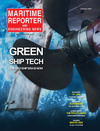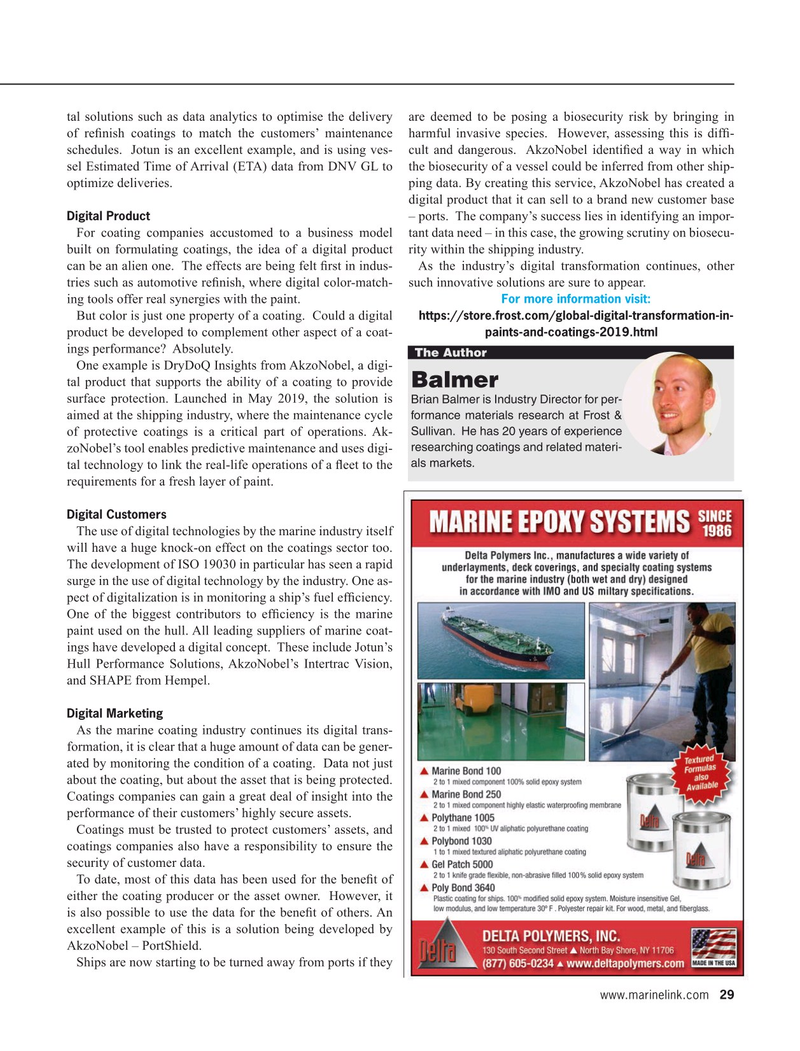
Page 29: of Maritime Reporter Magazine (February 2020)
Green Ship Technology
Read this page in Pdf, Flash or Html5 edition of February 2020 Maritime Reporter Magazine
tal solutions such as data analytics to optimise the delivery are deemed to be posing a biosecurity risk by bringing in of re? nish coatings to match the customers’ maintenance harmful invasive species. However, assessing this is dif? - schedules. Jotun is an excellent example, and is using ves- cult and dangerous. AkzoNobel identi? ed a way in which sel Estimated Time of Arrival (ETA) data from DNV GL to the biosecurity of a vessel could be inferred from other ship- optimize deliveries. ping data. By creating this service, AkzoNobel has created a digital product that it can sell to a brand new customer base
Digital Product – ports. The company’s success lies in identifying an impor-
For coating companies accustomed to a business model tant data need – in this case, the growing scrutiny on biosecu- built on formulating coatings, the idea of a digital product rity within the shipping industry. can be an alien one. The effects are being felt ? rst in indus- As the industry’s digital transformation continues, other tries such as automotive re? nish, where digital color-match- such innovative solutions are sure to appear. ing tools offer real synergies with the paint. For more information visit:
But color is just one property of a coating. Could a digital https://store.frost.com/global-digital-transformation-in- product be developed to complement other aspect of a coat- paints-and-coatings-2019.html ings performance? Absolutely.
The Author
One example is DryDoQ Insights from AkzoNobel, a digi- tal product that supports the ability of a coating to provide
Balmer surface protection. Launched in May 2019, the solution is
Brian Balmer is Industry Director for per- formance materials research at Frost & aimed at the shipping industry, where the maintenance cycle
Sullivan. He has 20 years of experience of protective coatings is a critical part of operations. Ak- researching coatings and related materi- zoNobel’s tool enables predictive maintenance and uses digi- als markets. tal technology to link the real-life operations of a ? eet to the requirements for a fresh layer of paint.
Digital Customers
The use of digital technologies by the marine industry itself will have a huge knock-on effect on the coatings sector too.
The development of ISO 19030 in particular has seen a rapid surge in the use of digital technology by the industry. One as- pect of digitalization is in monitoring a ship’s fuel ef? ciency.
One of the biggest contributors to ef? ciency is the marine paint used on the hull. All leading suppliers of marine coat- ings have developed a digital concept. These include Jotun’s
Hull Performance Solutions, AkzoNobel’s Intertrac Vision, and SHAPE from Hempel.
Digital Marketing
As the marine coating industry continues its digital trans- formation, it is clear that a huge amount of data can be gener- ated by monitoring the condition of a coating. Data not just about the coating, but about the asset that is being protected.
Coatings companies can gain a great deal of insight into the performance of their customers’ highly secure assets.
Coatings must be trusted to protect customers’ assets, and coatings companies also have a responsibility to ensure the security of customer data.
To date, most of this data has been used for the bene? t of either the coating producer or the asset owner. However, it is also possible to use the data for the bene? t of others. An excellent example of this is a solution being developed by
AkzoNobel – PortShield.
Ships are now starting to be turned away from ports if they www.marinelink.com 29
MR #2 (18-33).indd 29 2/7/2020 3:36:14 PM

 28
28

 30
30
